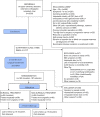Non-surgical and surgical treatments for rotator cuff disease: a pragmatic randomised clinical trial with 2-year follow-up after initial rehabilitation
- PMID: 33272959
- PMCID: PMC8142425
- DOI: 10.1136/annrheumdis-2020-219099
Non-surgical and surgical treatments for rotator cuff disease: a pragmatic randomised clinical trial with 2-year follow-up after initial rehabilitation
Abstract
Background: Rotator cuff disease (RCD) causes prolonged shoulder pain and disability in adults. RCD is a continuum ranging from tendinopathy to full-thickness tendon tear. Recent studies have shown that subacromial decompression and non-surgical treatments provide equivalent results in RCD without a full-thickness tendon lesion. However, the importance of surgery for full-thickness tendon tears remains unclear.
Methods: In a pragmatic, randomised, controlled trial, 417 patients with subacromial pain underwent 3-month initial rehabilitation and MRI arthrography (MRA) for the diagnosis of RCD. Of these, 190 shoulders remained symptomatic and were randomised to non-surgical or surgical treatments. The primary outcomes were the mean changes in the Visual Analogue Scale for pain and the Constant Murley Score for shoulder function at the 2-year follow-up.
Results: At the 2-year follow-up, both non-surgical and surgical treatments for RCD reduced pain and improved shoulder function. The scores differed between groups by 4 (95% CI -3 to 10, p=0.25) for pain and 3.4 (95% CI -0.4 to 7.1, p=0.077) for function. Among patients with full-thickness ruptures, the reduction in pain (13, 95% CI 5 to 22, p=0.002) and improvement in function (7.0, 95% CI 1.8 to 12.2, p=0.008) favoured surgery.
Conclusions: Non-surgical and surgical treatments for RCD provided equivalent improvements in pain and function. Therefore, we recommend non-surgical treatment as the primary choice for patients with RCD. However, surgery yielded superior improvement in pain and function for full-thickness rotator cuff rupture. Therefore, rotator cuff repair may be suggested after failed non-surgical treatment.
Trial registration details: ClinicalTrials.gov, NCT00695981 and NCT00637013.
Keywords: orthopedic procedures; patient reported outcome measures; rehabilitation; tendinopathy.
© Author(s) (or their employer(s)) 2021. Re-use permitted under CC BY-NC. No commercial re-use. See rights and permissions. Published by BMJ.
Conflict of interest statement
Competing interests: None declared.
Figures



Comment in
-
Correspondence on 'Non-surgical and surgical treatments for rotator cuff disease: a pragmatic randomised clinical trial with 2-year follow-up after initial rehabilitation'.Ann Rheum Dis. 2023 Apr;82(4):e102. doi: 10.1136/annrheumdis-2020-219751. Epub 2021 Feb 3. Ann Rheum Dis. 2023. PMID: 33536162 No abstract available.
-
Response to: 'Correspondence on 'Non-surgical and surgical treatments for rotator cuff disease: a pragmatic randomised clinical trial with 2-year follow-up after initial rehabilitation'' by Randelli et al.Ann Rheum Dis. 2023 Apr;82(4):e103. doi: 10.1136/annrheumdis-2020-219782. Epub 2021 Feb 3. Ann Rheum Dis. 2023. PMID: 33536163 No abstract available.
References
-
- Brox JI, Gjengedal E, Uppheim G, et al. . Arthroscopic surgery versus supervised exercises in patients with rotator cuff disease (stage II impingement syndrome): a prospective, randomized, controlled study in 125 patients with a 2 1/2-year follow-up. J Shoulder Elbow Surg 1999;8:102–11. 10.1016/S1058-2746(99)90001-0 - DOI - PubMed
Publication types
MeSH terms
Associated data
LinkOut - more resources
Full Text Sources
Medical

